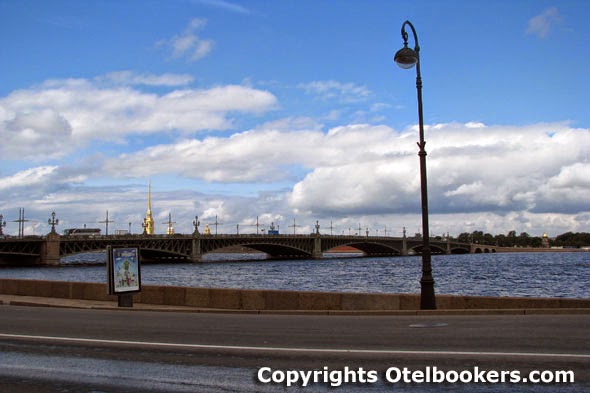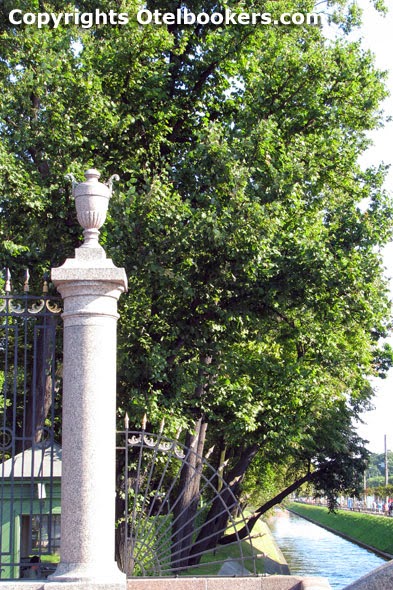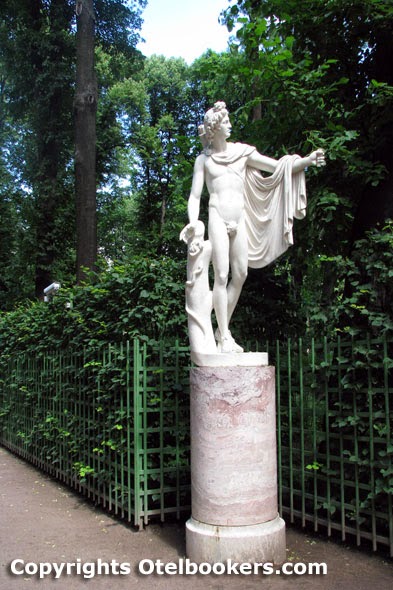A real paradise in the center of the Northern Capital of Russia
 |
| Photo credit: http://www.pronebo.info/ |
Summer Garden is a real paradise located in the heart of St. Petersburg. It is a very special place that enchants with its extraordinary beauty. This is the place where famous talented people of art: musicians, poets, artists, and actors used to get inspiration for creating their master-pieces while wandering around the alleys of Summer Garden.
If to be precise... Initially they could get to the park only at the invitation of Peter I. Later only decently dressed people could walk in Summer Garden.
In the 19th century the park became a favorite place for entertainments of St. Petersburg nobility.
Such figures of Russian culture as Aleksandr Pushkin, Ivan Krylov, Vasily Zhukovskiy, Ivan Goncharov, Aleksandr Block, Peter Tchaikovsky and many others frequented Summer Garden.
The park was a favorite place of people in love too. In fact, noble merchants' families with their daughters came to Summer Garden. Merchants' wives together with their daughters lined up on both sides of the alleys and young single merchants went about choosing brides for themselves. Every mother tried to dress up her daughter better than others did. It was a so-called competition among merchants' families.
 Saint-Petersburg celebrates its anniversary on the 27th of May every year. When it had its 300th anniversary in 2012, in the same year new reconstructed Summer Garden opened its doors in front of its residents and guests. The restoration work was for almost three years, and during that period of time restorers tried to do their best in order visitors could see Summer Garden the way it had been in the 18th century. Visiting this green island in the center of the Northern capital you can feel transported to the gone era and can get to know the city on the Neva better.
Saint-Petersburg celebrates its anniversary on the 27th of May every year. When it had its 300th anniversary in 2012, in the same year new reconstructed Summer Garden opened its doors in front of its residents and guests. The restoration work was for almost three years, and during that period of time restorers tried to do their best in order visitors could see Summer Garden the way it had been in the 18th century. Visiting this green island in the center of the Northern capital you can feel transported to the gone era and can get to know the city on the Neva better.
From the history of Summer Garden
 The artisan Ivan Ugrumov started construction of Summer Garden under the guidance of Peter I in the year of 1704. The tsar dreamed to have his own Versailles, his own summer royal residence. Peter the Great even drew the initial project himself. He planed to create a regular architectural park with a proper layout, straight alleys, nicely trimmed trees and bushes.
The artisan Ivan Ugrumov started construction of Summer Garden under the guidance of Peter I in the year of 1704. The tsar dreamed to have his own Versailles, his own summer royal residence. Peter the Great even drew the initial project himself. He planed to create a regular architectural park with a proper layout, straight alleys, nicely trimmed trees and bushes.
Under the guidance of Peter I and Ivan Ugrumov the territory of the future park was drained. In order to fulfill it a drainage channel was dug there. Also the garden was planned in a proper way, trees were planted, the 1st fountains were built. In 1704 a small harbor was created too where small crafts came. In the year of 1705 walls of the small harbor were enclosed with stone slabs. Thereby, it became the 1st paved promenade of Saint-Petersburg.
Summer Garden is surrounded with water from all sides. Rivers Neva and Fontanka became the only park boundary from north and east, and from south and west - the Moika and Lebyazhya Kanavka or Swan Canal. From the Neva, the central entrance three parallel-arranged straight alleys lead into Summer Garden which are crossed with perpendicular tracks. By the way, Swan Canal 648 meters long was dug there in the 1711-1719-s. It owes its name to the swans which settled there.
Summer Garden were divided into three parts. The northern part adjacent to the palace of Peter I was known as the First Summer Garden. There in the 1710-1714-s according to the project of the architect Domenico Trezzini a small two-storeyed palace for the tsar was built that has survived until our days. It was called the Summer Palace where from 1712 till 1725 during the warm months Peter I lived as during the cold months he lived in some other palace called the Winter Palace about which we will tell you in our next Blogger lenses.
The southern part from Swan Canal till Moika River was called the Second Summer Garden where they dug a pond known as "Karpiev Pond" or "Carp Pond". And the part of the south of the river was considered to be the Third Summer garden, it is modern Mihailovskiy Garden and the territory around the Mihailovskiy Palace.
In 1712 the Dutch gardener Jan Roozen was invited to Saint-Petersburg by Peter the Great who worked in Summer Garden till 1726. Thanks to his efforts Summer Garden acquired features of the Dutch Regular Gardens. For its decoration they brought rare trees and bushes, various flowers, marble statues to Saint-Petersburg from everywhere.
The main alley of Summer Garden, the most beautiful and solemn, was decorated with 12 paired marble columns and its track was covered with black and white slabs. Also an ancient Greek statue of Venus, the goddess of love had been installed there that later was called Venus Tauride. It was the 1st ancient sculpture of a naked woman in Russia. But they had to put a guard near the statue as the city residents felt embarrassed by seeing " a naked woman with snow-white face" and each of them tried to put something on her.Nowadays Venus is kept in the Hermitage.
In Peter's the Great opinion all the garden sculptures would not only have to decorate Summer Garden but also to have educational nature. With the help of their symbolic system, the tsar Peter I tried to accustom Russian people to the ancient mythology and European culture.
Peter I brought the sculptures brought for Summer Garden from Italy and he treasured them a lot. In the 18th century, there were more than 200 statues there. However, many of them were destroyed during flood. Also for 300 years the adverse climatic conditions did the trick too. Only around 90 original statues have been managed to be saved from the valuable collection which were created by great masters of the Venetian School. The saved original sculptures were shifted to some other suburban summer royal residences and to the Hermitage.
Nowadays Summer Garden is decorated with 90 sculptures-replicas of high quality made of artificial marble which are ready to tell visitors about ancient Greek gods - patrons of art, elements and human emotions. Among the statues of ancient mythology heroes you can also see busts of Alexander the Great, Julius Caesar, the Roman emperors Nero and Trajan and many others and allegorical statues of natural phenomena and abstract concepts such as "Night", "Morning", "Sunset". One of the most charming statues is considered to be "Cupid and Psyche" that located near Swan Canal.
Besides it, there were around 50 beautiful fountains built in Summer Garden. They were the 1st fountains in Russia. In order to make them work they had dug a channel and a steam-engine had pumped water from "Unnamed Erik" that was later called River Fontanka.
Unfortunately, the severe flooding in the year of 1777 destroyed fountains and they decided not to restore them. However, during restoration of the park already in modern times they managed to restore the water supply system according to the old drawings and run fountains again.
On the bank of the Fontanka they also built a Grotto according to the project of the architect Andreas Schluter that was very similar to a fabulous cave. It looked like a rectangular pavilion with a dome. Its walls were decorated with columns and sculptures. There were three halls in the Grotto which were decorated with shells, colored stones and ground glass.At the entrance of the Grotte a gilded chariot of Neptune on a mountain welcomed its visitors and inside under the mountain there was a languished lion. Neptune was considered to be an impersonation of Peter the Great and the lion - an impersonation of Sweden. Unfortunately, the Grotto was also destroyed during the flooding in the year of 1777. In reality, there were the two severe flooding ( in the year of 1777 and in the year of 1824) in Saint-Petersburg that caused great losses of the master-pieces in Summer Garden.
However, in 1826 the architect Carlo Rossi erected a "Coffee House" on the same place where the pavilion "Grotto" had been.
In 1839 after numerous wars between Sweden and Russia the king Charles XIV of Sweden gave a dark red porphyry vase to the tsar Nicholas I. It was like a gesture of goodwill from the Swedish side. The big porphyry vase became a real decoration of Summer Garden. It is made of pink granite, and its height together with the plinth is 485 centimeters. The vase was installed near the entrance from the embankment of the Moika between "Carp Pond" and the fence called "South Fence".
By the way, the famous lattice fences appeared in Summer Garden from 1771 till 1884 according to the projects of the architects Peter Egorov and Yury Felten. And Yury Felten was a son of the chef of Peter the Great - Johann Felten.
Also on the lattice fence of Summer Garden you can see a memorial plaque put in the same place where in 1866 a revolutionary D. Karakozov wanted to shoot the Emperor Alexander II.
Till the middle of the 19th century tapestries existed in summer Garden too.
In the 50-s in the 19th century they installed a monument dedicated to the Russian fablelist Ivan Krylov, the sculptor of which was Peter Klodt. The sculptor portrayed Ivan Krylov sitting on a rock and holding an opened book in his hands. The pedestal of the monument was decorated with illustrations from the most famous fables of Ivan Krylov.
During the Great Patriotic War among centuries-old trees of Summer Garden there were anti-aircraft guns for protection of the city from attacks of Nazis. And on lawns of the park instead of flowerbeds they created so-called kitchen-gardens which saved many lives during the Siege of Leningrad.
The latest things in Summer Garden are the following one:
- the Archaeological Museum where you can see interesting objects found by archaeologists during the reconstruction work in Summer Garden;
- the Small Greenhouse with Garden "Aptekarskiy";
- the Poultry House.
And now after getting to know the history on Summer Garden above, let's go on a virtual tour around Summer Garden. We would like to offer you to find yourself in a paradise in the heart of Saint- Petersburg on a sunny July day in the year of 2013. Enjoy!
The Famous Lattice Fence - The Main Gate from the Neva
 |
| River Neva |
Swan Canal near Summer Garden
At the end of Swan Canal there is a reddish spot. This is the Mihailovskiy Castle. On the right you can see the House of Ivan Beckiy that is also known as the Palace of the Prince of Oldenburg. From 1791 till 1796 the Russian fablelist Ivan Krylov lived there. He organized a printing press there too where such magazines as "The Spectator" and "The St. Petersburg Mercury".
By the way, except writing his famous fables, Ivan Krylov was fond of playing the violin too. But he did it in a very eccentric way: he played the violin completely naked. And ladies who were wandering around Summer Garden saw a completely naked man playing the violin very often as the windows of his flat were always opened. The police hat to interfere in that incident and asked the great Russian classic to draw the curtains while his enjoyment of playing the violin at least as it was impossible to walk in that part of Summer Garden.
 |
| The Mihailovskiy Castle |
The Alleys of Summer Garden
 |
| The Central Alley of Summer Garden |
The Summer Palace of Peter the Great
 |
| The view to Prachechnyi Bridge or Laundry Bridge on River Fontanka near the Summer Palace of Peter I |
The Fountain "Tsaritsyn"
Here is the Fountain "Tsaritsyn" or "Queen's" . It is the 1st fountain that you we will see on the Central Alley of Summer Garden from the Neva side. It was named after the empress Catherine I, the 2nd wife of Peter the Great. This is the place where the empress welcomed her guests.
The Bosquet "Menazheriyny Pond"
The Fountain "Gerbovyi" on the Central Alley
 |
| The Fountain "Gerbovyi" or "Armorial" |
The Legendary Statues of Summer Garden
Ancient Greek gods - patrons of art, elements and human emotions...
The Poultry House
 Here is the "Poultry Yard" with the "Dovecote". In the 18th century poultry yards and menageries were a mandatory attribute of any regular garden. In Summer Garden in the Poultry Yard they used to keep rare animals and birds. For example, eagles, black storks, cranes lived there, and in the "Dovecote" there were rare doves.
Here is the "Poultry Yard" with the "Dovecote". In the 18th century poultry yards and menageries were a mandatory attribute of any regular garden. In Summer Garden in the Poultry Yard they used to keep rare animals and birds. For example, eagles, black storks, cranes lived there, and in the "Dovecote" there were rare doves.
Nowadays there is a small museum in this building - "The Museum of History and Archaeology of Summer Garden".
The Monument of Ivan Krylov
One of the greatest Russian classics - the creator of famous fables and also an "extraordinary violinist"

The Fountain "Pyramid" on the Central Alley
The Fountain "Pyramid" was created by the decree of the empress Catherine I. It is a replica of the fountain" located in Petergof.
The Front Park Parterre and the Fountain "Koronnyi"
or the Fountain "Crown"
The "Small Greenhouse" and "Red Garden"
The Pavilion "Coffee House"
 The pavilion "Coffee House" is situated opposite the fountain "Pyramid", on the embankment of River Fontanka. It was created by Carol Rossi in the year of 1826 on the same place where the legendary pavilion "Grotto" was that had been destroyed during the severe flooding of the year of 1777. During the restoration work in 1925 they discovered underground tunnels under it. And in the 1960-s they found out that under the "Coffee House" the old foundation of the pavilion "Grotto" has remained.
The pavilion "Coffee House" is situated opposite the fountain "Pyramid", on the embankment of River Fontanka. It was created by Carol Rossi in the year of 1826 on the same place where the legendary pavilion "Grotto" was that had been destroyed during the severe flooding of the year of 1777. During the restoration work in 1925 they discovered underground tunnels under it. And in the 1960-s they found out that under the "Coffee House" the old foundation of the pavilion "Grotto" has remained.
"Karpiev Pond" or "Carp Pond"
The Big Porphyry Vase
The gift of the king Charles XIV of Sweden
Summer Garden is a real paradise where you can have a spiritual rest as it is considered to be the Museum of Art.
By the way, on Sundays they usually organize various exhibitions and performance of a brass band.
By the way, on Sundays they usually organize various exhibitions and performance of a brass band.






























































No comments:
Post a Comment